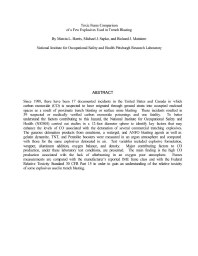Mining Publication: Toxic Fume Comparison of a Few Explosives Used in Trench Blasting
Original creation date: February 2003
Authors: ML Harris, MJ Sapko, RJ Mainiero
NIOSHTIC2 Number: 20022620
In: Proceedings of the 29th Annual Conference on Explosives and Blasting Technique (Nashville, TN, Feb. 2-5, 2003). Vol. 2. Cleveland, OH: International Society of Explosives Engineers; :319-336
Since 1988, there have been 17 documented incidents in the United States and Canada in which carbon monoxide (CO) is suspected to have migrated through ground strata into occupied enclosed spaces as a result of proximate trench blasting or surface mine blasting. These incidents resulted in 39 suspected or medically verified carbon monoxide poisonings and one fatality. To better understand the factors contributing to this hazard, the National Institute for Occupational Safety and Health (NIOSH) carried out studies in a 12-foot diameter sphere to identify key factors that may enhance the levels of CO associated with the detonation of several commercial trenching explosives. The gaseous detonation products from emulsions, a watergel, and ANFO blasting agents as well as gelatin dynamite, TNT, and Pentolite boosters were measured in an argon atmosphere and compared with those for the same explosives detonated in air. Test variables included explosive formulation, wrapper, aluminum addition, oxygen balance, and density. Major contributing factors to CO production, under these laboratory test conditions, are presented. The main finding is the high CO production associated with the lack of afterburning in an oxygen poor atmosphere. Fumes measurements are compared with the manufacturer's reported IME fume class and with the Federal Relative Toxicity Standard 30 CFR Part 15 in order to gain an understanding of the relative toxicity of some explosives used in trench blasting.

NIOSHTIC2 Number: 20022620
In: Proceedings of the 29th Annual Conference on Explosives and Blasting Technique (Nashville, TN, Feb. 2-5, 2003). Vol. 2. Cleveland, OH: International Society of Explosives Engineers; :319-336
- CO Migration from Trench Blasting in Amherst, New York
- Dangers of Toxic Fumes from Blasting
- Factors Affecting ANFO Fumes Production
- Factors Affecting Fumes Production of an Emulsion and ANFO/Emulsion Blends
- Field Studies of CO Migration from Blasting
- Low Temperature Limits for Mixing Recycled Oil, Diesel Fuel, and Ammonium Nitrate to Make ANFO-Type Blasting Agents
- Monitoring and Removal of CO in Blasting Operations
- NIOSH Hazard ID 3 - Carbon Monoxide Poisoning and Death After the Use of Explosives in a Sewer Construction Project
- A Technique for Measuring Toxic Gases Produced by Blasting Agents
- Technology News 488 - Migration of Blasting Fumes into a Western Pennsylvania Home